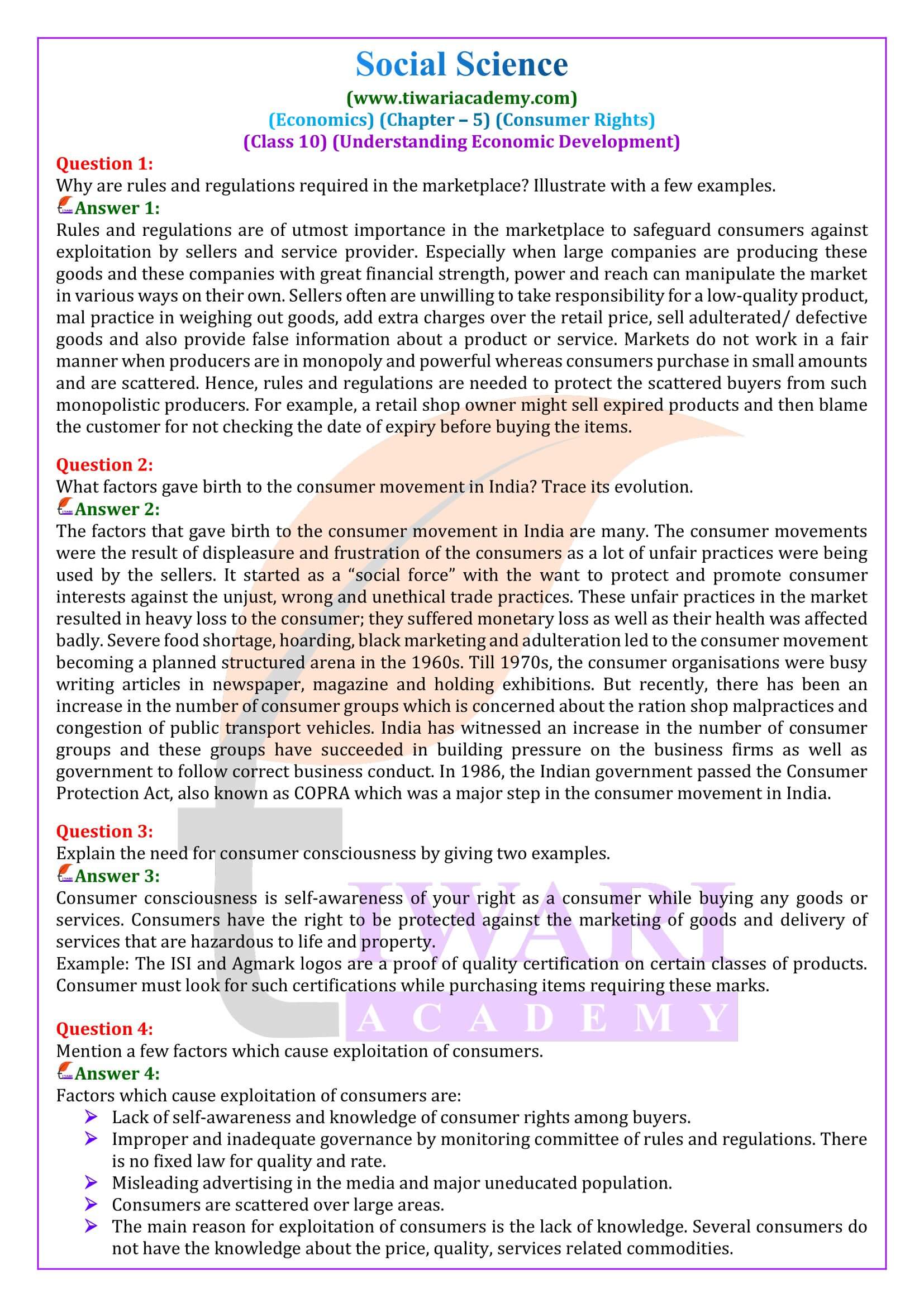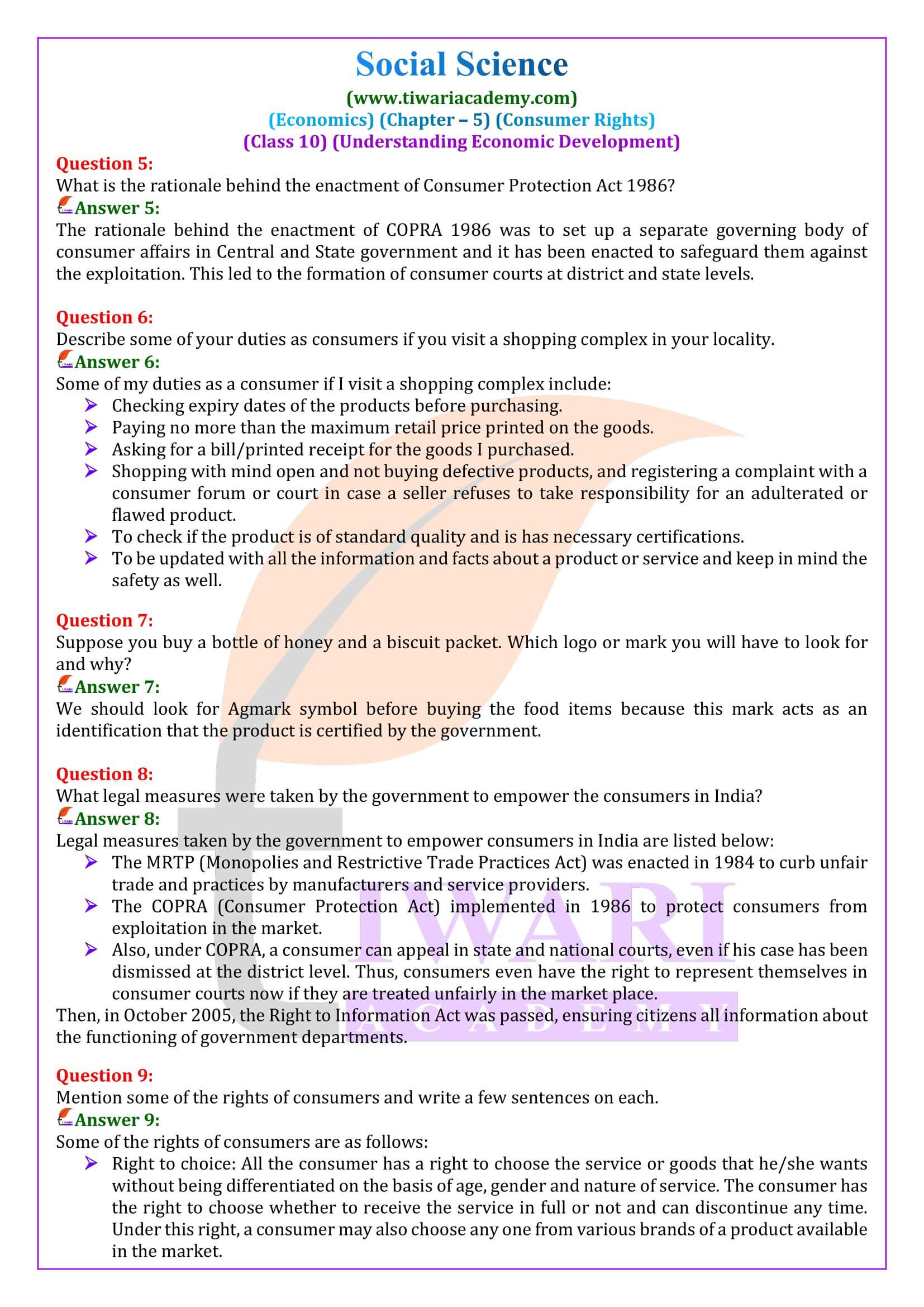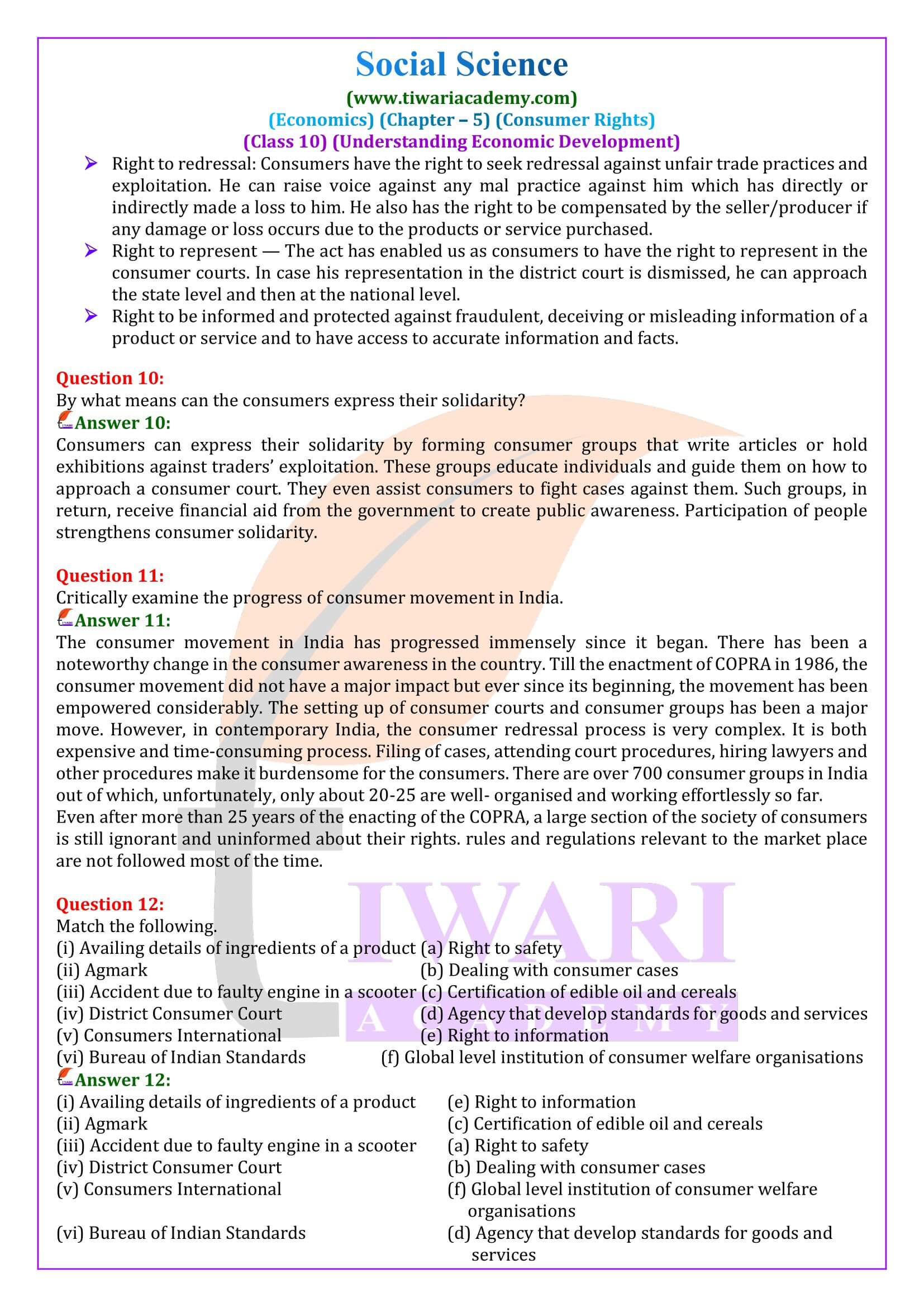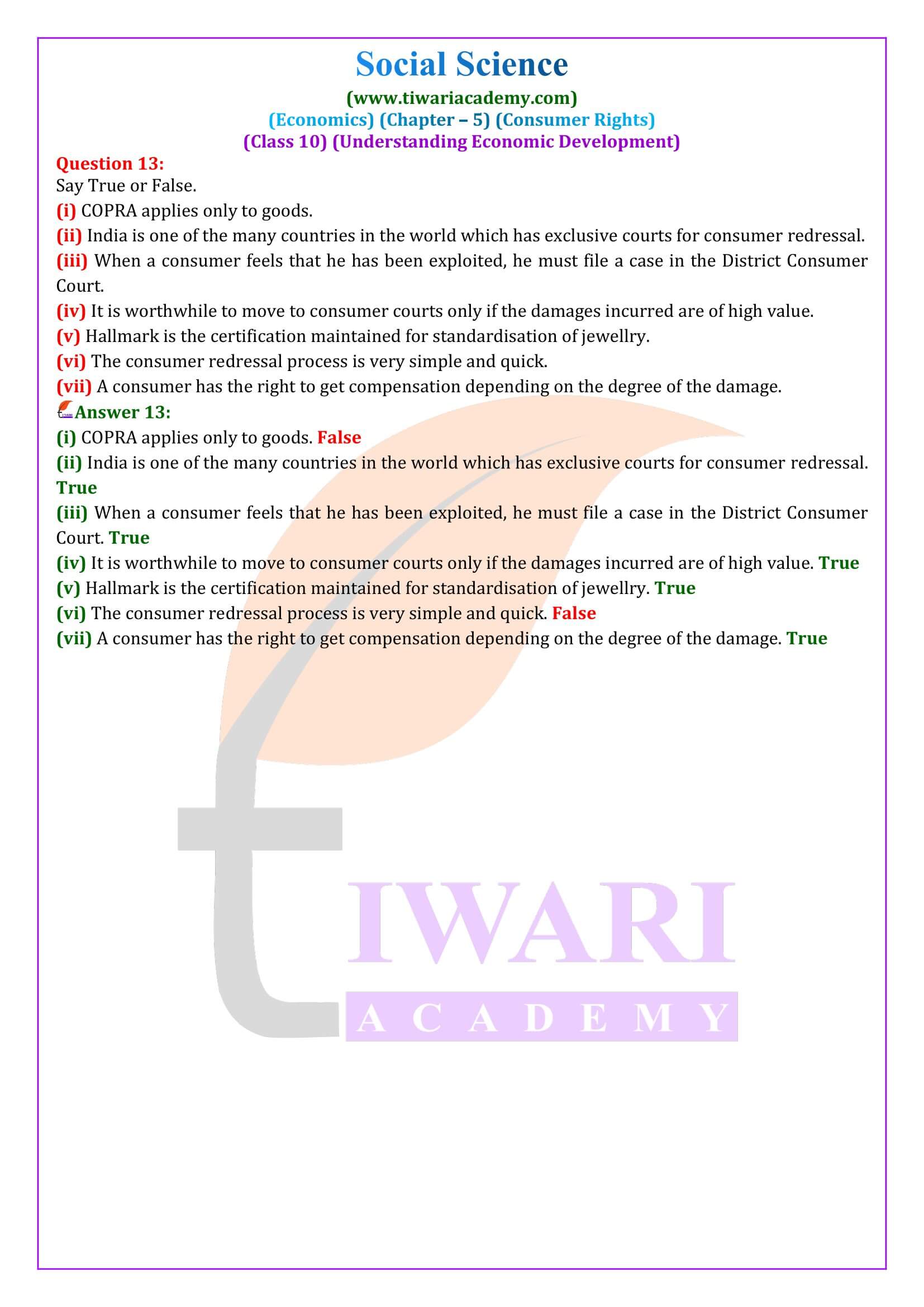NCERT Solutions for Class 10 Economics Chapter 5 Consumer Rights in Hindi and English Medium. Questions of this chapter will be asked in board examination and for project work in session 2024-25. Visit to discussion forum to ask more questions related to curriculum or solutions. Download offline and online apps of CBSE Solutions from App Store or Play Store.
NCERT Solutions for Class 10 Economics Chapter 5
| Class: | 10 |
| Subject: | Social Science – Economics |
| Chapter 5: | Consumer Rights |
NCERT Solutions for Class 10 Economics Chapter 5 in PDF
NCERT Solutions for Class 10 Economics Chapter 5 in PDF form is given below. Questions of this chapter will not be asked in board examination. It is just for project work and extra knowledge based chapter. Download NCERT Books based on latest CBSE Syllabus and new Offline Apps for new academic session 2024-25.
Exatra Questions Class 10 Economics Chapter 5
What are the different ways of exploitation of consumers in the market?
The different ways of exploitation of consumers in the market are:
Higher price
Quality lapse
Underweight & under measurement
False information and promises
Poor after sale service
Rude behavior
Inadequate safety measures
Market malpractices such as adulteration black marketing, duplicate articles etc.
What are the certifications for Quality assurance?
The certifications for Quality assurance are:
ISI Mark
AGMARK
HALLMARK
What is the difference between consumer protection council and consumer court?
The consumer protection council promotes and protects the various rights of the consumer.
The consumer court is made to hear the cases regarding a consumer complaint.
Consumer protection council is an advisory body, while consumer court is a quasi-judiciary body.
What are the reasons for exploitation of consumers?
The reasons for exploitation are as follows:
Lack of awareness
Lack of information about goods & markets
Limited supplies and competitions.
Lack of government support to consumers
Lack of interest on the part of the consumers in responding
Inadequacy of consumer movement
Important Terms related to Consumer Rights
Consumer is a person who buys and uses a good or service from the market after making
a payment.
COPRA: The consumer Protection Act enacted by the government of India on 24th December 1986.
Right to information act 2005: This act gives rights to the citizen to have information about the government departments, their policies practices and procedures.
MRP: It is the maximum retail price printed on packages goods. The seller cannot charge more than this price.
ISI Mark: a certification mark for industrial products in India developed by the Bureau of Indian Standards.
AGMARK: A certification mark employed on agricultural products in India by the directorate of Marketing and Inspection
Hallmark: An official mark struck on items made of precious metals like gold silver platinum etc.
Consumer Forum: The consumer movement in India has led to the formation of various organizations locally known as consumer forums or consumer protection councils. They guide consumers on how to file cases in the consumer court.
Consumer Rights under the COPRA
Consumer Rights under the COPRA are:
RIGHT TO SAFETY
RIGHT TO INFORMATION
RIGHT TO CHOICE
RIGHT TO BE HEARED OR
RIGHT TO REPRESENTATION
RIGHT TO CONSUMER EDUCATION
RIGHT TO SEEK REDRESSAL
Download NCERT Books and Offline Apps 2024-25 based on new CBSE Syllabus. Ask your doubts related to NIOS or CBSE Board and share your knowledge with your friends and other users through Discussion Forum.
Important Questions on Class 10 Economics Chapter 5
Why are rules and regulations required in the marketplace? Illustrate with a few examples.
Rules and regulations are of utmost importance in the marketplace to safeguard consumers against exploitation by sellers and service provider. Especially when large companies are producing these goods and these companies with great financial strength, power and reach can manipulate the market in various ways on their own. Sellers often are unwilling to take responsibility for a low-quality product, mal practice in weighing out goods, add extra charges over the retail price, sell adulterated/ defective goods and also provide false information about a product or service. Markets do not work in a fair manner when producers are in monopoly and powerful whereas consumers purchase in small amounts and are scattered. Hence, rules and regulations are needed to protect the scattered buyers from such monopolistic producers. For example, a retail shop owner might sell expired products and then blame the customer for not checking the date of expiry before buying the items.
What factors gave birth to the consumer movement in India? Trace its evolution.
The factors that gave birth to the consumer movement in India are many. The consumer movements were the result of displeasure and frustration of the consumers as a lot of unfair practices were being used by the sellers. It started as a “social force” with the want to protect and promote consumer interests against the unjust, wrong and unethical trade practices. These unfair practices in the market resulted in heavy loss to the consumer; they suffered monetary loss as well as their health was affected badly. Severe food shortage, hoarding, black marketing and adulteration led to the consumer movement becoming a planned structured arena in the 1960s. Till 1970s, the consumer organisations were busy writing articles in newspaper, magazine and holding exhibitions. But recently, there has been an increase in the number of consumer groups which is concerned about the ration shop malpractices and congestion of public transport vehicles. India has witnessed an increase in the number of consumer groups and these groups have succeeded in building pressure on the business firms as well as government to follow correct business conduct. In 1986, the Indian government passed the Consumer Protection Act, also known as COPRA which was a major step in the consumer movement in India.
Explain the need for consumer consciousness by giving two examples.
Consumer consciousness is self-awareness of your right as a consumer while buying any goods or services. Consumers have the right to be protected against the marketing of goods and delivery of services that are hazardous to life and property. Example: The ISI and Agmark logos are a proof of quality certification on certain classes of products. Consumer must look for such certifications while purchasing items requiring these marks.
Mention a few factors which cause exploitation of consumers.
Factors which cause exploitation of consumers are: Lack of self-awareness and knowledge of consumer rights among buyers. Improper and inadequate governance by monitoring committee of rules and regulations. There is no fixed law for quality and rate. Misleading advertising in the media and major uneducated population. Consumers are scattered over large areas. The main reason for exploitation of consumers is the lack of knowledge. Several consumers do not have the knowledge about the price, quality, services related commodities.
What is the rationale behind the enactment of Consumer Protection Act 1986?
The rationale behind the enactment of COPRA 1986 was to set up a separate governing body of consumer affairs in Central and State government and it has been enacted to safeguard them against the exploitation. This led to the formation of consumer courts at district and state levels.
Describe some of your duties as consumers if you visit a shopping complex in your locality.
Some of my duties as a consumer if I visit a shopping complex include: Checking expiry dates of the products before purchasing. Paying no more than the maximum retail price printed on the goods. Asking for a bill/printed receipt for the goods I purchased. Shopping with mind open and not buying defective products, and registering a complaint with a consumer forum or court in case a seller refuses to take responsibility for an adulterated or flawed product. To check if the product is of standard quality and is has necessary certifications. To be updated with all the information and facts about a product or service and keep in mind the safety as well.
Suppose you buy a bottle of honey and a biscuit packet. Which logo or mark you will have to look for and why?
We should look for Agmark symbol before buying the food items because this mark acts as an identification that the product is certified by the government.








